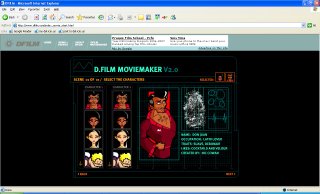 Via Maarten Boers I got to know about Dfilm: a service with which you can create your own animation film online for free.
Via Maarten Boers I got to know about Dfilm: a service with which you can create your own animation film online for free.Maaike is our intern doing interviews with members of the e-collaboration group about their experiments with collaboration via new e-technologies. She thought of presenting her research on a blog and we had a meeting with the communications people of two organisations. At the end of the meeting she made a joke which inspired me to create this animation film about our meeting.
The meeting outlined a sort of dilemma with new technologies. At the one hand, a new technology by itself is attractive, and you should probably stimulate experimentation. On the other hand, you don't want technology to drive a solution and really want to think about the optimal choice of technology starting from the information need/audience. But if you overdo that, you may kill the initial enthusiasm.
At the end we kind of decided to try to get a blog going and produce a good old paper report as well. (and Maaike asked me to write down that in real life she is much smarter as in the animation :))
So my question is: how can you use this kind of animation in online interactions? Do you use it to summarize or stimulate discussion? Are there people who might be put off by an animation?














